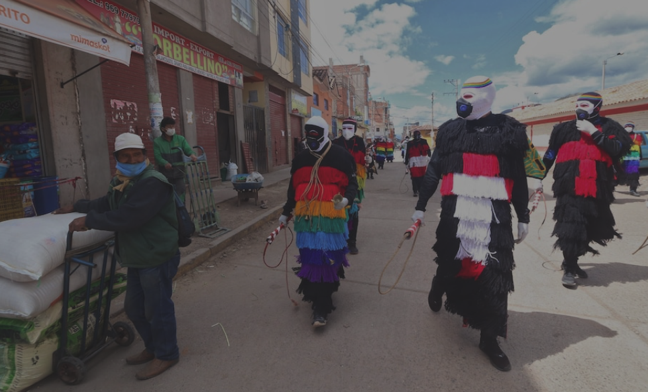
(above) Men dressed as Andean Ukukus or Pabluchas, traditional characters who act as vigilantes imposing social order, brandish whips as a threat to compel people to maintain their distance and remind them to wear face masks and gloves near Cusco, Peru. (Jose Carlos Angulo/AFP/Getty Images)
From the Andes to Tibet, the coronavirus seems to be sparing populations at high altitudes
June 1, 2020 - Original article: Washington Post
When tourists from Mexico, China and Britain became the first covid-19 fatalities in Cusco, Peru, it seemed as if the onetime capital of the Inca Empire might be headed for a significant outbreak.
Nestled in a picturesque Andean valley, the high-altitude city of 420,000 residents, the gateway to the cloud forest citadel of Machu Picchu, receives more than 3 million international visitors per year — many from pandemic hot spots, including the United States, Italy and Spain.
Yet since those three deaths, between March 23 and April 3, at the start of Peru’s strict national lockdown, there has not been another covid-19 fatality in the entire Cusco region, even as the disease has claimed more than 4,000 lives nationally.
Infections have also remained low. Just 916 of Peru’s 141,000 cases come from the Cusco region, meaning its contagion rate is more than 80 percent below the national average.
The relative dearth of cases and deaths in the internationally connected but high-elevation region has prompted speculation here that the coronavirus gets soroche, the Quechua word for altitude sickness.
Similar results have been seen elsewhere in the Andes, and in Tibet.
Sign up for our Coronavirus Updates newsletter to track the outbreak. All stories linked in the newsletter are free to access.
Peru took early, aggressive measures against the coronavirus. It’s still suffering one of Latin America’s largest outbreaks.
Scientists warn that the apparent pattern might not last, but the as-yet-unexplained phenomenon has them intrigued. Researchers are starting to investigate a possible relationship between the coronavirus and altitude.
In one peer-reviewed study, published in the journal Respiratory Physiology & Neurobiology, researchers from Australia, Bolivia, Canada and Switzerland looking at epidemiological data from Bolivia, Ecuador and Tibet found populations living above 3,000 meters (9,842 feet) reported significantly lower levels of confirmed infections than their lowland counterparts.
They found that Tibet’s infection rate was “drastically” lower than that of lowland China, three times lower in the Bolivian Andes than in the rest of the country and four times lower in the Ecuadoran Andes.
Ecuador has suffered one of Latin America’s worst outbreaks, with more than 38,000 reported cases and more than 3,300 deaths, according to official figures. But it has been centered on the Pacific port of Guayaquil. Bolivia’s 8,387 cases have been concentrated in the department of Santa Cruz, just a few hundred feet above sea level. But the department of La Paz, home to the world’s highest capital, has had just 410 cases.
The researchers hypothesize that populations living at high altitudes might be benefiting from a combination of an ability to cope with hypoxia (low levels of oxygen in the blood) and a natural environment hostile to the virus — including dry mountain air, high levels of UV radiation and the possibility that lower barometric pressure reduces the virus’s ability to linger in the air.
Other experts question the role of the environmental factors, noting that most coronavirus infections occur indoors, making UV levels irrelevant. But they are calling for more research into high-altitude populations’ response to the coronavirus, including the possibility that when infected, they sicken less and are therefore less likely to seek medical treatment or testing.
Bodies lie in the streets of Guayaquil, Ecuador, emerging epicenter of the coronavirus in Latin America
“The virus likes people. It doesn’t care about altitude,” says Peter Chin-Hong, who studies infectious diseases at the University of California at San Francisco. “But we’re still learning so much about this disease, and this does provide us with some good clues to try and understand its progression.”
Just three populations in the world have been found to have genetic adaptations to altitude: Himalayans, Ethiopian highlanders and Andeans. Yet Clayton Cowl, a pulmonologist at the Mayo Clinic and a former president of the American College of Chest Physicians, suspects the trend may be more closely related to acclimatization, the body’s ability to adjust temporarily to altitude, than to DNA.
That could explain why the coronavirus is raging on Peru’s Pacific coast,
particularly Lima, where most residents descend from Andean ancestors, while the country’s mountain communities have thus far at least avoided the worst.
Cowl notes that prolonged exposure to altitude triggers a chain reaction in the lungs involving a protein known as ACE2 that might prevent pulmonary shunting, a problem common among covid-19 patients.
Ordinarily, when a part of the lung is damaged, the body redirects the flow of blood toward healthier areas that are better able to absorb oxygen. Shunting stops that process of redirection, resulting in hypoxia. It is, according to Cowl, a common element among the roughly 30 percent of covid-19 patients who exhibit mild symptoms yet have unusually low levels of oxygen in their blood — and who sometimes take a sudden turn for the worse.
Chile’s ‘immunity passport’ will allow recovered coronavirus patients to break free from lockdown, get back to work
But any benefits from altitude in coping with a coronavirus infection, Chin-Hong and Cowl said, would come only with full acclimatization, a process that typically takes three months. They both stressed that anyone suffering a coronavirus infection who traveled to a mountain area would normally see their symptoms worsen.
“Otherwise we could treat them with a hyperbaric chamber,” Cowl said.
“From an epidemiological perspective, it is hard to know what this means. There’s likely to be a variety of factors, but it is truly interesting.”
Coronavirus on the border: Patients from Mexico overwhelm California hospitals
Venezuela’s broken health system is uniquely vulnerable to coronavirus
In Brazil, a dying man, and a desperate search for a hospital bed